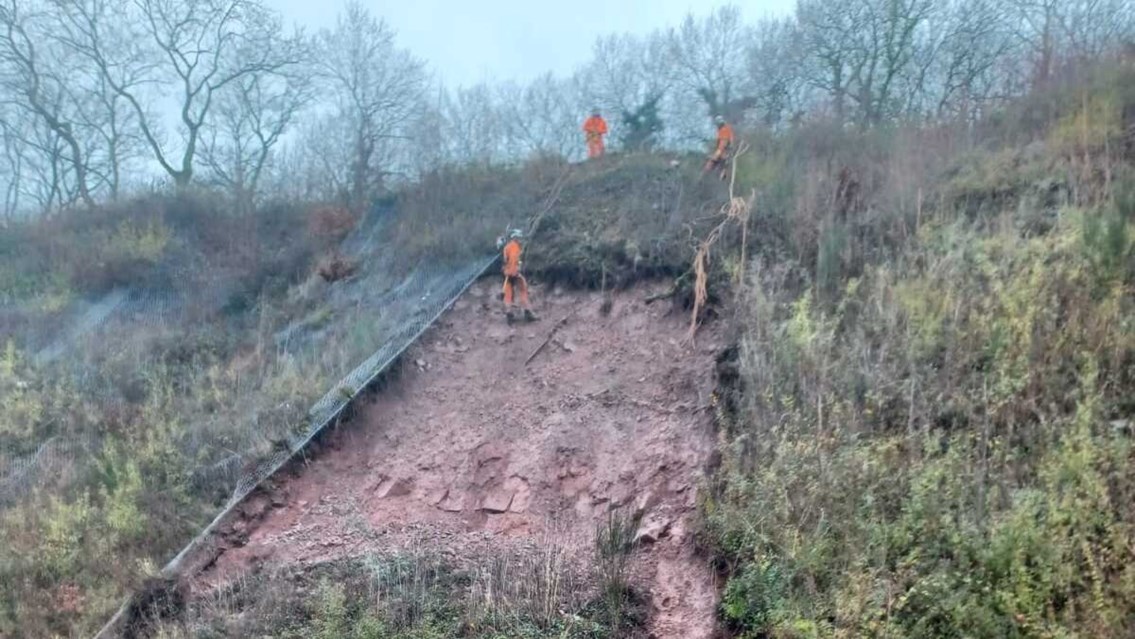Wednesday 11 Jan 2023
New year landslip highlights need for Network Rail’s ongoing resilience upgrades on Newport to Gloucester railway line
- Region & Route:
- Wales & Western: Wales & Borders
The line was forced to close in early January following a 100-tonne landslip, highlighting the need for Network Rail’s continued investment to protect the Wales and Borders railway from the impacts of climate change
Network Rail was alerted to the movement of earth by its state-of-the-art slope monitoring system, on Wednesday 4 January, following a bout of prolonged and heavy rain.
Over the next four days, rope access teams worked around the clock to descale the 100ft cliff face, near Purton, by hand and remove the large amount of soil and rock from the tracks.
The extreme rain caused a culvert to collapse and washed away four-tonnes of ballast - the stones beneath the tracks - with engineers carrying out repairs to both in the coming days. Concrete ‘legado blocks’ were also installed at the bottom of the slopes to prevent further debris from reaching the track.
The Severn Estuary Railway Line is particularly vulnerable to landslips due to its exposed location. In 2021, Network Rail announced a £25m project to enhance resilience of this vital passenger and freight route with its Severn Estuary Resilience Programme.
An ongoing project, Network Rail is undertaking the mammoth task of installing 27,000 square metres of a new rock-mesh-system along a three-mile section of the line, including at the location of this most recent landslip.
This project began in Summer 2022 and will continue from Summer 2023. The investment will ensure this vital railway link is protected from the effects of climate change for generations to come.
Christopher Howchin, senior network delivery manager for Network Rail Wales & Borders, said: “I’d like to thank the team for their efforts to recover the line as quickly and safely as possible, especially during the latest period of industrial action, when our resources were limited.
“Landslips at this location are only going to become more frequent due to the increasing bad weather brought on by climate change, which is why we are investing millions of pounds to protect our railway from the impact. Our work on this line will reduce delays and disruption for passengers and our freight customers, ensuring this vital transport route can continue to serve communities for many years to come.”
Contact information
Passengers / community members
Network Rail national helpline
03457 11 41 41
Latest travel advice
Please visit National Rail Enquiries
Journalists
Callum Jones
callum.jones2@networkrail.co.uk
About Network Rail
We own, operate and develop Britain's railway infrastructure; that's 20,000 miles of track, 30,000 bridges, tunnels and viaducts and the thousands of signals, level crossings and stations. We run 20 of the UK's largest stations while all the others, over 2,500, are run by the country's train operating companies.
Usually, there are almost five million journeys made in the UK and over 600 freight trains run on the network. People depend on Britain's railway for their daily commute, to visit friends and loved ones and to get them home safe every day. Our role is to deliver a safe and reliable railway, so we carefully manage and deliver thousands of projects every year that form part of the multi-billion pound Railway Upgrade Plan, to grow and expand the nation's railway network to respond to the tremendous growth and demand the railway has experienced - a doubling of passenger journeys over the past 20 years.
Follow us on Twitter: @networkrail
Visit our online newsroom: www.networkrailmediacentre.co.uk

